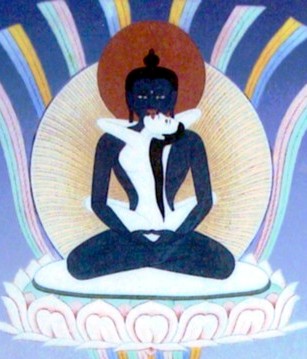Dzogchen: Difference between revisions
No edit summary |
No edit summary |
||
| Line 1: | Line 1: | ||
'''Dzogchen''' ([[wyl.]] ''rdzogs chen''), or Dzogpachenpo - the ‘Great Perfection’, or ‘Great Completeness’. The practice of Dzogchen is the most ancient and direct stream of wisdom within the Buddhist tradition of Tibet. It is the heart-essence of all spiritual paths and the summit of an individual’s spiritual evolution. As a way in which to realize the innermost nature of mind—that which we really are—Dzogchen is the clearest, most effective, and most relevant to the modern world. Simple yet profound, it is a path that can be integrated with ordinary life and practised anywhere. | [[Image:Samantabhadra.jpg|frame|'''The Primordial Buddha Samantabhadra''']]'''Dzogchen''' ([[wyl.]] ''rdzogs chen''), or Dzogpachenpo - the ‘Great Perfection’, or ‘Great Completeness’. The practice of Dzogchen is the most ancient and direct stream of wisdom within the Buddhist tradition of Tibet. It is the heart-essence of all spiritual paths and the summit of an individual’s spiritual evolution. As a way in which to realize the innermost nature of mind—that which we really are—Dzogchen is the clearest, most effective, and most relevant to the modern world. Simple yet profound, it is a path that can be integrated with ordinary life and practised anywhere. | ||
==From ''Dzogchen and Padmasambhava'' by [[Sogyal Rinpoche]]== | ==From ''Dzogchen and Padmasambhava'' by [[Sogyal Rinpoche]]== | ||
Revision as of 19:02, 13 June 2007

Dzogchen (wyl. rdzogs chen), or Dzogpachenpo - the ‘Great Perfection’, or ‘Great Completeness’. The practice of Dzogchen is the most ancient and direct stream of wisdom within the Buddhist tradition of Tibet. It is the heart-essence of all spiritual paths and the summit of an individual’s spiritual evolution. As a way in which to realize the innermost nature of mind—that which we really are—Dzogchen is the clearest, most effective, and most relevant to the modern world. Simple yet profound, it is a path that can be integrated with ordinary life and practised anywhere.
From Dzogchen and Padmasambhava by Sogyal Rinpoche
Dzogchen is both the final and ultimate teaching, and the heart of the teachings of all the Buddhas. Though generally associated with the Nyingma or Ancient School of Tibetan Buddhism founded by Padmasambhava, Dzogchen has been practised throughout the centuries by masters of all the different schools as their innermost practice. Its origins reach back to before human history, and neither is it limited to Buddhism, nor to Tibet, nor indeed even to this world of ours, as it is recorded that it has existed in thirteen different world systems.
Dzogchen is an abbreviation of the Tibetan word Dzogpachenpo. ‘Dzogpa’ means ‘complete’, or ‘the end’; ‘chenpo’ means ‘great’. It is widely translated as “Great Perfection”, but this may imply a perfection that we strive to attain, a journey towards a goal of Great Perfection, and this is not the meaning of Dzogchen. Dzogchen is explained as Ground, Path and Fruition, and from the point of view of the Ground of Dzogpachenpo, it is the already self-perfected state of our primordial nature, which needs no ‘perfecting’, for it has always been perfect from the very beginning, just like the sky. It is uncreated, yet spontaneously accomplished.
Traditionally ‘Dzogchen’ can be traced to two original Sanskrit terms. The first is Mahasandhi, which means the gathering of all or the quintessence, signifying that Dzogchen is the very essence, the cream and the heart juice of all teachings. Hence many of the teachings are known as ‘Nyingtik’ or ‘Heart Essence’, for example the Longchen Nyingtik.
The second term is Atiyoga, which means ‘primordial yoga’; Ati indicates the topmost, summit or zenith. It has the sense of scaling a mountain, reaching the peak and having a view over everything. For Atiyoga or Dzogchen stands at the apex of the characteristic Nyingmapa presentation of the Buddhist path as Nine Yanas or vehicles, with the three Inner Tantras special to the Nyingma tradition: Mahayoga, Anuyoga and Atiyoga. The zenith of all yanas, Atiyoga represents the culmination of an individual’s spiritual evolution, the point where all spiritual disciplines and paths have been traversed. The term ‘Maha Ati’ has also been used for Dzogchen in recent times by masters like Chögyam Trungpa Rinpoche.
Further Reading
- The Tibetan Book of Living and Dying, pages 155-56
- The Nine Yanas, ‘Dzogchen Atiyoga ‘, pages 16-25.